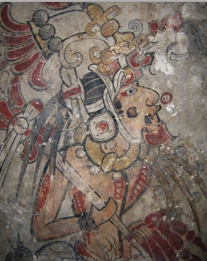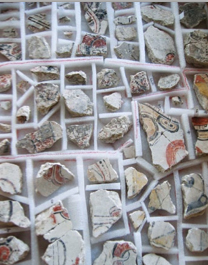November 1, 2013






In September, representatives from the AIA traveled to Pilsen in the Czech Republic to participate in the 19th Annual Meeting of the European Association of Archaeologists (EAA). The city of Pilsen is the fourth-largest city in the Czech Republic and has been designated the European Capital of Culture for 2015. The conference, hosted by the University of West Bohemia, officially opened on Wednesday, September 4. Nearly 1,400 archaeologists from Europe and the rest of the world—48 countries in total—attended the meeting, which featured 977 papers and 196 posters. While topics on European prehistory and history dominated the meeting’s academic program, there were several important sessions on public archaeology, cultural heritage management, and the role of professional organizations in archaeology.
AIA Director of Programs, Ben Thomas, presented information on two AIA programs at the meeting. A poster titled “International Archaeology Day and Public Outreach” was included in the session “Public Archaeology from the Ground Up.” The poster discussed the global impact of Archaeology Day and its effectiveness as a large-scale public outreach program—more than 60,000 people participated in Archaeology Day events in 2012. International Archaeology Day is a popular concept with our European colleagues, and representatives from several countries joined our efforts in 2013. In a paper titled “Preparing for Archaeotourists: What Can We Do?” the AIA also discussed our collaboration with the Adventure Travel Trade Association (ATTA), which resulted in the production of a set of guidelines for tourists visiting archaeological sites. As a result of connections made at the conference, we are now working with several of our European colleagues to translate the guidelines for distribution in Europe.
In addition to participating in academic sessions, AIA staff attended a lunch hosted by the president of the EAA that included representatives from the EAA, the Society for American Archaeology (SAA), and the World Archaeological Congress (WAC). The lunch was an opportunity for guests to discuss current issues and future collaborations. The AIA had a table in the conference’s exhibit area. At the table we presented our publications, resources, and programs to hundreds of meeting participants.
The EAA annual meeting is an opportunity for the AIA to strengthen its relationship with one of the leading archaeological organizations in Europe, build relationships with European colleagues, and reach out to a wider audience. The 2014 EAA meeting will be in Istanbul, Turkey.
The AIA is happy to announce that the Institute’s new online Career Center is open for business. The Career Center will connect professional archaeologists to a variety of employment opportunities and will track job openings for archaeologists in academic departments, museums, research centers, contract firms, and more.
The Center is open to all job seekers at no charge. Job seekers will be able to create profiles and post their curricula vitae and relevant documents online. Profiles can be protected or open to the public and searchable. Individuals will be able to search all job listings, set up custom searches, and be automatically notified when new job postings are listed.
For potential employers, the Career Center offers a variety of options for posting open positions. Registered employers will be able to submit job listings and browse through information about potential candidates in the database. Additionally, companies will have the opportunity to reserve a table or booth in the AIA-APA Annual Meeting exhibit hall or an interview room/suite in the conference facilities.
Visit the AIA Career Center at www.archaeological.org/careers, or click on “Jobs” on the AIA Facebook page for the most up-to-date listings. Registration for job seekers is easy and free.
Thanks to a grant from the Leon Levy Foundation, the AIA will soon be able to make the extensive archival materials from its 134-year history available online. The archives are a collection of paper, photographic, and audio-visual materials that document the history of the Institute from its founding in 1879 to the present. An invaluable tool for researchers, these materials are currently only accessible to scholars who come to the Institute’s headquarters in Boston.
The AIA Archives Project, set to begin immediately, will inventory, digitize, and translate all of the records, correspondence, publications, and other materials that have been collected from past officers, governing board members, committee members, and staff. The project is slated for completion in 2016. Upon completion, the entire archive will be publicly accessible through the AIA’s host institution, Boston University. AIA President Elizabeth Bartman applauded the grant: “The Leon Levy Foundation’s generous support will facilitate not only an understanding of our institutional past but also of what was, at the time of the AIA’s founding in 1879, a new discipline of study. At its heart, a study of the AIA is an exploration of intellectual history.”
The 115th Joint Annual Meeting (AM) of the Archaeological Institute of America (AIA) and the American Philological Association (APA) will be held at the Hyatt Regency Chicago Hotel from January 2 to 5, 2014. The annual four-day gathering of more than 3,000 is the oldest and largest professional meeting of archaeologists, philologists, and classical scholars in North America. In Chicago, the academic program will begin on January 3 and will feature several colloquia, workshops, panel and roundtable discussions, and poster sessions. Last year’s Annual Meeting in Seattle featured more than 800 papers presented in 140 sessions to a crowd of 2,300 attendees, making it the largest academic program on record.
But academic papers are only one part of a diverse program that will include a public lecture by Garrett Fagan, Associate Professor of Classics and Ancient Mediterranean Studies at Penn State University, multiple receptions and dinners, and the annual AIA Awards Ceremony, which honors members who have made important contributions to the discipline. With its varied program and agenda, the Annual Meeting is a wonderful opportunity for attendees to discuss the latest archaeological findings and research, network with other members of the archaeological community, and socialize with colleagues and friends. For more information about the meeting, registration, and housing, visit www.archaeological.org/annualmeeting.
A special pledge drive held at the AIA Spring Gala in New York City on April 24 raised $10,000 for the conservation and reconstruction of the extraordinary murals uncovered at the Maya site of San Bartolo in Guatemala. The elaborate murals at San Bartolo are some of the earliest discovered in the area and date to the Preclassic period (1500 B.C.–A.D. 250). The mythological themes featured on the fragile artworks provide insight into the ideological concerns of the ancient Maya people who occupied the site. Since 2001, conservators have been stabilizing and conserving the murals both in the lab and at the site. The AIA is pleased that the money raised at our gala will assist with the preservation of these important and rare paintings. To read more about this project, visit www.archaeological.org/project/sanbartologuatemala.
Professional archaeologists and students alike report that their number one challenge in pursuing archaeological research stems from a lack of funding opportunities. Members of the AIA community are invited to help us address this increasingly urgent need through the creation of named and endowed fellowships or scholarships.
What is an endowed fellowship or scholarship? An endowed fellowship or scholarship is a special gift that creates a perpetual financial source used to provide professional archaeologists or students with an opportunity to conduct research, organize an excavation, present or publish one’s findings, or participate in a field school. The options are vast.
What is the minimum amount needed to establish an endowed fellowship or scholarship? It depends on what you envision! Endowed funds can be started with a minimum gift of $10,000. This amount can be paid all at once, or through a series of payments.
In addition to providing a permanent stream of income, endowment funds are a meaningful way to honor or memorialize family members, friends, mentors, or colleagues. There are many ways to establish an endowed fund with the AIA; each one provides for the healthy, long-term future of the discipline of archaeology. To learn more about how to support archaeological research and discovery, contact Jennifer Klahn, 617-353-8709 or jklahn@aia.bu.edu.